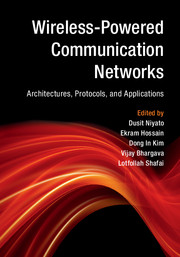Book contents
- Frontmatter
- Contents
- List of contributors
- Preface
- Part I Basics of Wireless Energy Harvesting and Transfer Technology
- Part II Architectures, Protocols, and Performance Analysis
- Part III Applications of Wireless Energy Harvesting and Transfer
- 9 Sensor Networks with Wireless Energy Harvesting
- 10 Cognitive Radio Networks with Wireless Energy Harvesting
- 11 Mobile Ad-Hoc Networks and Delay-Tolerant Networks With Wireless Energy Harvesting
- Index
- References
11 - Mobile Ad-Hoc Networks and Delay-Tolerant Networks With Wireless Energy Harvesting
from Part III - Applications of Wireless Energy Harvesting and Transfer
Published online by Cambridge University Press: 01 December 2016
- Frontmatter
- Contents
- List of contributors
- Preface
- Part I Basics of Wireless Energy Harvesting and Transfer Technology
- Part II Architectures, Protocols, and Performance Analysis
- Part III Applications of Wireless Energy Harvesting and Transfer
- 9 Sensor Networks with Wireless Energy Harvesting
- 10 Cognitive Radio Networks with Wireless Energy Harvesting
- 11 Mobile Ad-Hoc Networks and Delay-Tolerant Networks With Wireless Energy Harvesting
- Index
- References
Summary
Introduction
Mobile ad-hoc Networks (MANETs) are composed of mobile nodes communicating over multiple hops from a source to a destination. They do not have an infrastructure such as a base station or an access point to facilitate data transfer. Mobile nodes acting as relays receive data from the source or other relays and forward such data to the next hop until the destination has been reached. Delay-tolerant Networks (DTNs) are a special kind of MANET that will allow mobile nodes to receive, store, and forward data when they move and meet each other. Unlike in MANETs, in DTNs, there is no need for an end-to-end path from the source to the destination when the data are transferred. Thus, DTNs are suitable for non-real-time traffic, namely delay-tolerant traffic. Typically, in MANETs and DTNs, the energy supply to the mobile nodes in the networks is limited and intermittent. Additionally, mobility makes data transfer less reliable than in infrastructure-based wireless networks such as cellular systems. Therefore, when one adopts wireless energy harvesting and transfer, some related issues, e.g., routing and energy replenishment, have to be revisited.
This chapter deals with wireless-powered MANETs and DTNs. Firstly, overviews of MANETs and DTNs are presented. Some issues related to energy in conventional MANETs and DTNs are discussed. Then, the chapter presents in detail energy management approaches for mobile nodes in wireless-powered MANETs and DTNs.
• The first approach deals with content delivery services in a wireless-powered DTN. In the network, a mobile node acting as a mobile router moves randomly to collect content from a content source and deliver it to a gateway. The mobile node receives energy from the gateway, and thus must optimize energy usage for content delivery. A constrained Markov decision process (CMDP) is formulated and solved to obtain an optimal content delivery policy. Additionally, multiple mobile nodes can help each other to deliver content from different content sources. A coalition formation game is applied to determine an optimal coalition among mobile nodes.
• The second approach considers delay-limited communication in the wireless-powered MANET. The mobile node generates and has to transmit delay-sensitive data before a deadline. If the deadline is violated, the data become useless and will be discarded and lost.
- Type
- Chapter
- Information
- Wireless-Powered Communication NetworksArchitectures, Protocols, and Applications, pp. 383 - 429Publisher: Cambridge University PressPrint publication year: 2016



